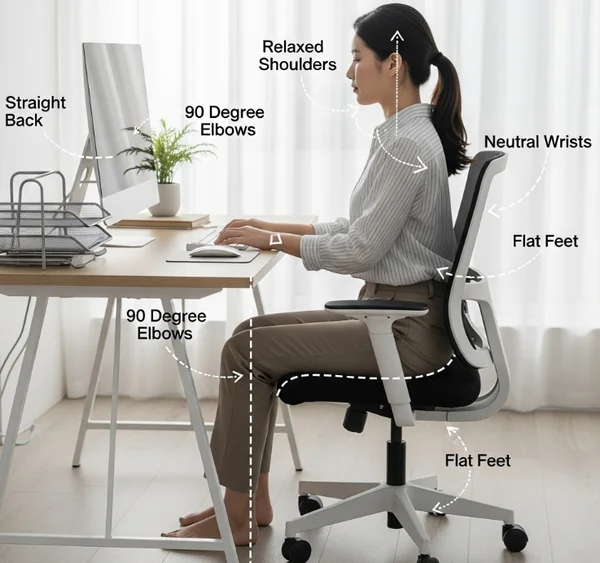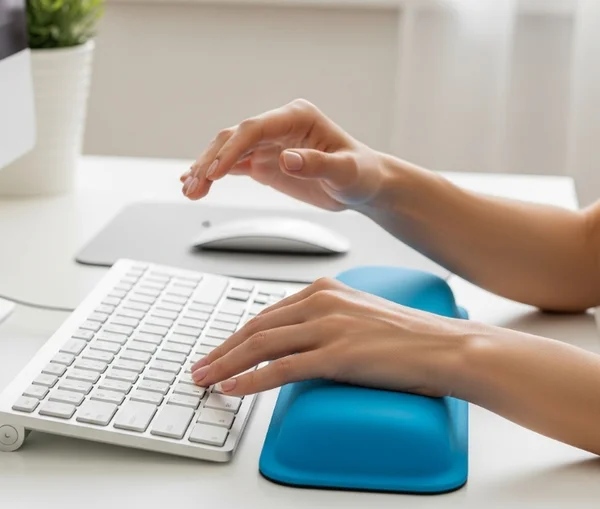Keyboards & Ergonomics: Gear Up for Better Typing Speed
Did you know that the right gear and setup can significantly impact your typing speed and comfort? Many users search for the best keyboard for typing or ask, What type of keyboard is best for fast typing? This guide delves into how choosing suitable keyboards and understanding typing ergonomics can boost your typing performance. We'll explore different keyboard layout options and ergonomic principles to help you type faster and more comfortably. Ready to see how your current setup affects your WPM? Test your typing speed with your current setup and then consider these tips!
Choosing the Right Keyboard for Your Typing Needs

Selecting the best keyboard for typing is a personal journey, but understanding the options is the first step to improve typing speed and comfort. Does keyboard layout affect typing speed? Absolutely, and so does the type of keyboard itself.
Mechanical vs. Membrane Keyboards: A Typist's Dilemma
One of the biggest debates is between mechanical keyboard and membrane keyboard options.
- Mechanical Keyboards: Favored by many for their tactile feedback, distinct actuation point, and durability. Different switch types (e.g., Cherry MX Blue, Brown, Red) offer varied typing experiences. They can lead to more precise keystrokes and potentially better typing efficiency.
- Membrane Keyboards: Generally quieter and often more affordable. They use a rubber dome under each key. While good for general use, some typists find them less responsive for high-speed typing compared to mechanical options.
Many ask, Are mechanical keyboards better for typing? For serious typists aiming for speed and accuracy, the feedback from a mechanical keyboard is often preferred, though it comes down to personal preference.
Understanding Keyboard Layouts: QWERTY, Dvorak, and More
The standard QWERTY layout is what most are familiar with. However, alternative layouts like the Dvorak layout or Colemak exist, designed to increase typing speed and reduce finger strain by placing common letters on the home row. While switching layouts has a steep learning curve, some users report significant typing performance gains. For most, optimizing their typing on QWERTY is more practical.

Considering Keyboard Size and Form Factor
Keyboards come in various sizes:
- Full-size: Includes the number pad.
- Tenkeyless (TKL): Omits the number pad for a more compact design, allowing the mouse to be closer.
- Compact (e.g., 60%, 65%): Even smaller, omitting function rows and arrow keys (often accessible via layers). The right size depends on your desk space and whether you need a dedicated number pad. A more compact keyboard can improve typing ergonomics by reducing shoulder abduction when using the mouse.
Mastering Typing Ergonomics for Comfort and Speed
Proper typing ergonomics are crucial not just for speed but also for preventing strain and discomfort during long typing sessions. How can ergonomics improve my typing WPM? By reducing fatigue and promoting efficient movement.
The Importance of Proper Typing Posture
Your typing posture significantly impacts your comfort and efficiency:
-
Sit upright: Keep your back straight, shoulders relaxed.
-
Feet flat: Ensure your feet are flat on the floor or a footrest.
-
Elbows at 90 degrees: Your elbows should be bent at roughly a 90-degree angle, with forearms parallel to the floor.
-
Wrists straight: Avoid bending your wrists up, down, or sideways while typing. Maintaining good posture is fundamental to comfortable typing.

Setting Up Your Workstation Ergonomically
Beyond posture, your workstation setup matters:
- Monitor height: The top of your screen should be at or slightly below eye level.
- Keyboard and mouse placement: Position them directly in front of you, close enough to avoid reaching.
- Chair adjustments: Ensure your chair provides good lumbar support and allows you to maintain the correct posture. An ergonomic setup directly contributes to better typing performance.
The Role of a Wrist Rest: Help or Hindrance?
How important is a wrist rest for typing? A wrist rest can provide support and comfort during breaks from typing. However, it's generally recommended not to rest your wrists on it while actively typing, as this can lead to awkward wrist extension and potentially hinder movement. If used, it should support the palms, not the wrists themselves, and primarily during pauses.

Beyond the Gear: Practice and Technique
While the right keyboard and ergonomics are vital, they are only part of the equation to increase WPM.
The Synergy Between Good Gear and Typing Practice
Even the best keyboard for typing won't magically make you faster without proper technique and consistent typing practice. Ergonomic gear makes practice more comfortable and sustainable. Once you have an optimal setup, it's time to hone your skills. You can check your WPM now to set a baseline.
How Touch Typing Maximizes Your Keyboard's Potential
Learning to touch type – typing without looking at the keys – allows you to fully leverage the design of any good keyboard. It ensures your fingers move efficiently and accurately. If you haven't mastered it, investing time in touch typing lessons can dramatically improve typing speed.
Testing Your Speed After Ergonomic Adjustments
After making changes to your keyboard or workstation setup, it's a good idea to re-evaluate your typing performance. Use an online keyboarding test to see if the adjustments have led to more comfortable typing and a better WPM score. Visit wpmtest.cc to measure your improvement and see the difference good ergonomics make.
Fine-Tuning Your Typing Environment for Peak Performance
Choosing the right keyboard and optimizing your typing ergonomics are crucial steps toward faster, more comfortable, and more efficient typing. Whether you opt for a mechanical keyboard or a different keyboard layout, remember that these tools work best when combined with good posture and consistent typing practice. Experiment to find what works best for you and watch your typing speed soar!
What's your favorite keyboard for typing, and what ergonomic tips have helped you the most? Share your experiences in the comments below!
Keyboards and Typing Ergonomics
Here are some common questions about keyboards and typing ergonomics.
What type of keyboard is best for fast typing?
Many fast typists prefer mechanical keyboards due to their tactile feedback and consistent actuation, which can improve accuracy and speed. However, the "best" keyboard is subjective and also depends on switch type preference (e.g., linear, tactile, clicky) and overall comfort. Some also find low-profile chiclet keyboards fast. Ultimately, you can test your WPM on different keyboards to see what suits you.
How can ergonomics improve my typing WPM?
Proper typing ergonomics reduce physical strain, fatigue, and discomfort, allowing you to type for longer periods with better focus and efficiency. Correct posture, keyboard/mouse placement, and monitor height minimize unnecessary movements and help maintain a natural body position, which can directly translate to an improved WPM. It makes your typing practice more effective.
Does keyboard layout affect typing speed?
Yes, keyboard layout can affect typing speed. While QWERTY is standard, alternative layouts like Dvorak or Colemak are designed to place frequently used keys on the home row, potentially reducing finger travel and increasing speed for those who master them. However, the learning curve for a new layout is steep. For most, optimizing technique on QWERTY is more practical.
Are mechanical keyboards better for typing than membrane ones?
Many typists find mechanical keyboards better for extended typing sessions due to their distinct feel, audible feedback (on some switches), and durability. This can lead to more precise keystrokes and a more satisfying typing experience, potentially improving speed and accuracy. However, membrane keyboards are quieter and often more budget-friendly. It's a good idea to try a typing test with both if possible.
What is the most ergonomic keyboard layout or type?
Ergonomic keyboards often feature a split design, tenting (angling the halves upwards), or a curved keywell to promote more natural hand, wrist, and forearm positions. Some specialized ergonomic layouts also exist. The "most" ergonomic is subjective, as it depends on individual body mechanics and preferences. The goal is to minimize strain, and for many, a split keyboard with a slight negative tilt can be beneficial for comfortable typing.